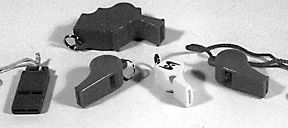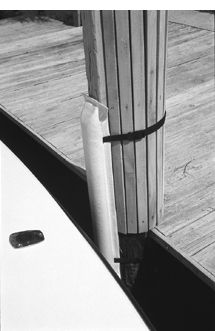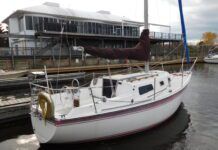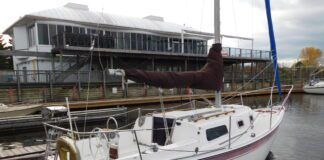When it comes to survival at sea, the more tools you have at your disposal, the better. And that includes, in addition to high-tech items, such low-tech devices as a reflecting mirror or a simple whistle. We took a look at whistles several years ago and found that all are not equal. With some new models on the market, we decided to pit one of our top picks last time, the Canadian-made Fox, against four other whistles commonly found in catalogs and chandleries.

We found two basic types of whistle: “pea-less” and “pea-ed”—that is, containing a small ball that reverberates when the whistle is blown. The pea-less type depends on the shape of its interior chamber or chambers to produce a tone and presumably is safer in a marine environment because it has no pea to get gummed up.
The testing was fairly straightforward. First, we tried out each whistle at a distance of 10 feet from our digital Radio Shack decibel meter; then we sounded them out in the field (literally a football field) to see how well each carried at ever-increasing distances; then we dunked them in water and saw how well they worked afterwards. We also considered such factors as size, design, ease of use, etc. Here’s what was found.
ACR Res-Q. Produced (in China) by the Florida firm best known for its EPIRBs, the Res-Q whistle is a small flat device that produces reasonably good volume but does not seem to have the penetrating pitch created by several other models. Loud enough in a closed room at 10 feet, the ACR lost volume at 50 and 100 yards in the outdoor testing. Comes with lanyard.
Fox 40. The top pick, the diminutive Fox gave out a shrill scream that was both loud and penetrating, indoors and out. The three-chambered whistle creates a harmonic “beat” that rises above ambient noise, according to company director Alan Martlim. Maybe that’s why it’s the official whistle of the NFL and also popular, Martlim says, with Coast Guard personnel, hikers, and mountain ski patrols. It’s a keeper.
Seven Seas. This Maine company makes and/or distributes lots of different marine gear, much of it good. Its whistle is a pretty pedestrian affair, however, and a weak performer in the field. A few dollars cheaper than the Fox or Storm, but what’s a few dollars when your safety is on the line.
Storm. This US-made whistle claims to be the “loudest in the world!” (it was, barely, the loudest in our trials), and that, along with its distinct pitch, made it the equal of the Fox in carrying ability. It’s larger than the other whistles and oddly shaped (making it somewhat awkward to handle). The literature also claims it works under water; we didn’t try that nor do we think we’d expend our last lungful of air on blowing a whistle. Still, it’s a very good whistle, although we’ll give the nod to the little Fox that combines excellent performance with ease of use.
West Marine. Same Taiwan-made model as the Seven Seas, with very similar performance. However, you do get a pack of two for a savings over the Seven Seas, and West does provide its whistles with lanyards.
Click here to view the Whistles Value Guide.
Conclusion. In the water test, all of the whistles worked reasonably quickly after being submerged for some time, although the pea-ed type took a bit more clearing. Also, it seems, the smaller the whistle (i.e., the Fox), the less water that needs to be expelled from the chamber. We’d choose Fox first, Storm second, and the ACR a distant third. ACR did, however, provide information on the proper distress call—the SOS signal is three short, three long, three short. (ACR Electronics, 5737 Ravenswood Rd., Ft. Lauderdale, FL 33312; 954/981-3333. Fox, Ascent Inc., 2100 Old Lake Shore Rd., Burlington, Ontario, Canada; 800/361-0473. Seven Seas Marine, Rockland, ME 04841; All-Weather Whistle Co., Box 8615, St. Louis, MO 63126; 314/436-3332. West Marine, Box 50070, Watsonville, CA; 800/BOATING.)
Perimeter Piling Bumper: You Can Take It With You
If you’ve ever tied up to a strange dock, you know how much damage an unprotected piling or post can do to your hull. You also know how difficult it is to keep your fenders in place against a post in any but the ideal conditions.

Perimeter Industries has come up with an answer—one of those “Why didn’t I think of that?” solutions. It’s simply a removable fender that you attach to the post or piling, and remove when you leave the dock. The removable bumper consists of a more-or-less half-round fender measuring about 3-1/2″ across (with a 1″ wide tab on each side), 2-1/4″ deep and 36″ in length. It has two adjustable straps with side-accessible quick-release fasteners. It’s simple enough to use: Just snap it around a post or piling and adjust the straps to a tight fit.
Like other Perimeter fenders, the Removable Post Bumper is made of a closed-cell polyurethane foam (no inflation required) and is covered with woven polyester. There’s a five-year warranty. We can attest to the durability of Perimeter fenders because we’ve had some on a workboat for six years now, and aside from an occasional cleaning with a scrub brush and detergent they’ve needed no attention and still are in fine condition.
The Removable Dock Bumper we tested is the large model, which carries a suggested retail price of $44.95. It’s also available in a medium size that’s 2-1/2″ wide (plus a pair of 1″ tabs), 1-3/4″ deep and 36 “ long, and lists for $35.95. (Perimeter Industries, 1532 W. 132nd St., Gardena, CA 90249; 800/225-6636.)
Lightweight Power: Tohatsu (or Nissan) 9.8-hp. Outboard
Over the past half-dozen years or so, we’ve extolled the virtues of clean-running outboards—four-strokes and DFI two-strokes. We still applaud them for their fuel-efficiency and freedom from water pollution. And yet…we’re not sure we want to carry them around. Their undeniable virtues carry with them a considerable weight penalty. A typical 9.9-hp four-stroke, for example, weighs in at more than 100 lbs., as compared to the 75 lbs. or so that most 9.9-hp two-strokes weigh, providing a reminder of why two-strokes became popular in the first place.
Tohatsu (or Nissan) they’re identical except for cosmetics) has gone one step further. For some time now, they’ve been producing a 57-lb. 8-hp two-stroke. It’s sufficiently lighter than the competition to justify our choice of it as a test engine in our previous test of RIB tenders. During that test program it performed well, although some boat manufacturers felt that we should have tested their boats with a more powerful engine. While we understand their objections, we felt (and continue to feel) that the necessity of using a heavier, harder-to-handle engine is a valid reason to down rate such boats.
Well, Tohatsu/Nissan has introduced an engine that should make those boat manufacturers and many boaters happier. It’s a 9.8-hp two-stroke, essentially a hopped-up version of the 8-hp model. It still weighs 57 lbs.—actually, it’s indistinguishable from the 8 hp except for the numbers painted on the engine and its performance. Both engines displace 10.3 cubic inches, with a bore and stroke of 1.97″ x 1.69″. Both are available with either 15″ or 20″ shafts; both have the same 2.08:1 overall gear ratio and both have forward-neutral-reverse transmissions. Ignition is solid-state CD, with no points or condensers.
Both the 8 and 9.9 are essentially plain vanilla two-strokes. They don’t use fuel-injection or oil-injection (both consume 50:1 gas/oil premix), and the only options available are a 6.7-amp power supply and electric start (a feature that probably won’t interest people whose primary concern is light weight).
Neither the 8 nor the 9.8 is a particularly clean-burning engine. While this is unfortunate in terms of water pollution—normally a tender isn’t used for long enough trips to make fuel consumption a concern—we think that for many boat owners the ease in handling, lifting and lowering of these little engines may outweigh environmental concerns.
The 9.8 is priced at $210 more than the 8 hp. The MSRP for the Nissan-labeled engine is $1,743; the Tohatsu-labeled 9.8 lists for $1,716. (Nissan Marine, 1624 W. Crosby Rd., Ste. 101, Carrollton, TX 75006; 972/323-6003, www.nissanmarine.com. Tohatsu Outboards/Maruben, Engine and Power, 1624 W. Crosby Rd., Ste. 101, Carrollton, TX 75006; 972/323-6003, www.tohatsu.com.)



































